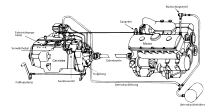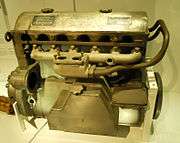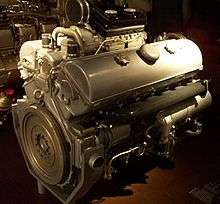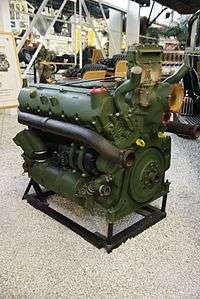List of WWII Maybach engines
This is an incomplete list of gasoline engines designed by Maybach AG, used in various German tracked military vehicles (mostly tanks and half-tracks) before and during World War II.
Nomenclature
1. Performance
- NL = Normalleistung (normal performance motor)
- HL = Hochleistung (high performance motor)
This is followed by the approx. engine capacity (e.g. HL42 = approx. 4.2 litres)
2. Installation
- P = Panzerkampfwageneinbau (tank installation)
- Z = Zerstorereinbau (tank destroyer installation)
e.g. HL45 Z, HL230 P30. These letters were only used on some models.
3. Lubrication
- TR = Trockensumpfschmierung (dry sump), generally fitted to tanks - due to low ground clearance, and some halftracks. There is no sump below the crankcase: the engine oil is contained in a tank on one side, sometimes with an external driveshaft passing through it in a tunnel.
- TU = Tiefer Unterteil ('deep lower part' i.e. wet sump), only fitted to some halftracks. The sump has an inverted triangle shape, bolted to the underneath of the crankcase housing.
4. Transmission

- K = Kupplung or Kupplungsgehäuse (clutch): a clutch and manual gearbox is attached directly to the flywheel end of the crankshaft. This type of transmission was fitted to all halftracks, both TR and TU types, and to early Panzer Is.
- If there is no clutch (K), a horizontal splined shaft connects the flywheel to a separate pneumatically-controlled pre-selector gearbox. Located next to the driver, it is operated by vacuum pressure generated by a compressor (R) - see next section. Various gearboxes were used, including the Maybach-Variorex 10-speed gearbox on the Panzer III (see diagram on right): this proved to be mechanically vulnerable.Other units included the ZF SSG 5x and 7x Aphon series pre-selector gearboxes (the SSG 75 had five forward gears and one reverse: the 76 and 77 had six and seven forward gears respectively). Bigger tank engines used a Maybach Olvar transmission.
5. Compressor
- R = Riemenantrieb für Luftpresser (belt drive for air compressor), driven by a pulley at the other end from the flywheel: this provided the pressure for a pneumatically-operated gearbox, eg the Maybach-Variorex, or the Olvar. On inline-6 models, the belt-driven compressor is mounted on the inlet side at the end away from the flywheel: on V-12 models, the compressor is located between the two banks of cylinders at the other end from the flywheel (see diagram above: part of the compressor pulley can be seen on the extreme top r. in the photo of the HL120 in § Gallery below).
- To shift gears with the Variorex, the pre-selector lever is set in the desired position or slot, and then the clutch pedal is depressed. The air inlet of the compressor is connected to the system, not the outlet: the compressor works "in reverse" to create a vacuum. Inside the Variorex gearbox there are vacuum-actuated pistons: these move dog clutches, which select the desired gearing.[1]
- Models fitted with a clutch (K) could also have a compressor fitted, which may have been used to power a secondary gearbox.
6. Ignition
- M = Schnapper-Magnetzündung (impulse magneto): some models had a Bosch 12-volt magneto for the ignition. On both 6- and 12-cylinder engines, the magneto (with distributor) is geared to the starter ring on the flywheel. Most models were also fitted with a belt-driven alternator for charging the batteries for the starter motor, lighting, etc. [2]
- The alternative to a magneto was an ignition coil connected to a vertically-mounted distributor driven from one end of the camshaft.[3]
Examples:
- NL38 TRKM = Normal performance 3.8 litre, dry sump, clutch, magneto
- HL57 TRR = High performance 5.7 litre, dry sump, pre-selector gearbox (no K), compressor, coil & distributor (no M)
- HL108 TUKRM = High performance 10.8 litre, wet sump, clutch, compressor, magneto
German WWII halftrack numbering may appear not to be strictly logical: in order of engine size and therefore towing capacity, they were numbered Sd.Kfz. 10, 11, 6, 7, 8, 9. The two smallest vehicles were introduced after most of the larger prime movers were in production.[4]
Design
A number of Maybach motors shared the same basic design but had different engine sizes, the larger engines having bigger cylinders to increase the capacity. Similar engine designs had shared parts lists, e.g. the NL38 and HL42; the HL57 and HL62; and the HL108 and HL120.[5]
The 6-cylinder Maybach engines used a single Solex 40 JFF II down-draught carburetor,[2] and earlier V-12s used two. Later V-12s used Solex 52 JFFs.[6]
Gallery


List of Maybach engines
| Model | Type | Capacity (Litres)[lower-alpha 1] | Power (PS)[lower-alpha 2] | @rpm | Application |
|---|---|---|---|---|---|
| HL25 | I-4 | 2.5 | 65 | 2,800 | Pre-production SdKfz 10[7] |
| HL30 | I-4 | 3.0 | 95 | 3,000 | Le.WS - Leichter Wehrmacht Schlepper (Light Army Tractor) (1st & 2nd models)[8][9] |
| NL38 TRKM[10] | I-6 | 3.791 | 90 | 3,000 | Panzer I Ausf. B and derivatives, e.g. 15 cm sIG 33 (Sf) auf Panzerkampfwagen I Ausf B:[11] SdKfz 10 D6 (pre-production):[12] early SdKfz 6[13][14] early SdKfz 11[15] |
| NL42 TUKRR[16] | I-6 | 4.170 | 100 | SdKfz 11: SdKfz 251 (various models, incl. /16 & /21)[17] | |
| HL42 TUKRM | I-6 | 4.170[18] | 100 | 2,800 | SdKfz 11, SdKfz 251 : SdKfz 250 |
| HL42 TRKM | I-6 | 4.170 | 110[15] | SdKfz 10 type D7 (production models) : SdKfz 11 | |
| HL42 TRKMS[19] | I-6 | 4.198 | 100 | 3,000 | Leichter Wehrmachtschlepper (Le.Ws) (late models) [8]Schwerer Wehrmachtschlepper (s.Ws)[20] |
| HL45 P | I-6 | 4.678 | 150 | Panzer I Ausf. C/F and Ausf. J[21] | |
| HL45 Z | I-6 | 4.678 | 150 | 3,800 | HKp 602/603 (prototype)[22] |
| HL50 P | I-6 | 4.995 | 180 | 4,000 | Kätzchen APC (prototype) |
| HL52 TU[23] | I-6 | 120 | SdKfz 7, 1st prod models | ||
| HL54 TUKRM | I-6 | 5.420 | 115 | 2,600 | SdKfz 6 (late models)[24] |
| HL57 TR | I-6 | 5.698 | 130 | 2,600 | SdKfz 7, 2nd batch: Panzer II Ausf. a[25] |
| HL62 TR/M | I-6 | 6.191 | 140 | Panzer II Ausf. b:[26] Wespe[27] | |
| HL62 TUK | I-6 | 6.191 | 140 | 2,600 | SdKfz 7, 3rd batch[24] |
| HL64 | I-6 | 140 | SdKfz 7 after 1943 | ||
| HL66 P | I-6 | 6.754 | 180 | 2,800 | Panzer II Ausf. G and L (Luchs)[28] |
| HL85 TUKRM | V-12 | 8.520[29] | 185 | 2,500 | SdKfz 8[30] |
| HL90 | V-12 | 9.99 | 200/360?[lower-alpha 3] | 3,600 | Heuschrecke 10 - Grasshopper SPG |
| HL98 TUK | V-12 | 230 | Pre-prod SdKfz 9[30] | ||
| HL108 TR | V-12 | 10.838 | 250 | Panzer III Ausf. A through C : Panzer IV Ausf. A (only 35 made)[31] | |
| HL108 TUKRM | V-12 | 10.838 | 250 | 3,000 | later SdKfz 9[32] |
| HL116 | V-12[lower-alpha 4] | 11.048 | 250[33][lower-alpha 5] | 3,300 | Sturer Emil : HK1600 (halftrack prototype)[33] |
| HL120 TR | V-12 | 11.867 | 300 | 2,000 | StuG III Ausf. A[34] |
| HL120 TRM112 | V-12 | 11.867 | 300 | Panzer III, Ausf E-N : StuG III: StuG IV : Hummel: Panzer IV Ausf B - J:[35] Elefant | |
| HL157 P[lower-alpha 6] | V-12 | 15.580 | 550? | 3,500 | VK 1602 Leopard (prototype) |
| HL174 | V-12 | 19.144 | 550? | 3,000 | VK 3601 (Henschel protoype)[36] |
| HL210 TRM P45 | V-12 | 21.353[37] | 650 | 3,000 | First 250 Panther Ausf. Ds[38] and early Tiger Is (aluminium alloy crankcase & block) |
| HL224 | V-12 | 22.4 | 600[lower-alpha 7] | 3,000 | VK 6501(H), (heavy tank prototype by Henschel based on Panzer IV) |
| HL230 P30 | V-12 | 23.095[39] | 750 | Later Panther Ds,[40] Jagdpanther, Tiger II (King Tiger),[41] : Jagdtiger : Sturmtiger : Panther II (prototype)[41] | |
| HL230 P45 | V-12 | 23.095 | 700 | 3,000 | later versions of the Tiger I and Sturmtiger (cast iron block) |
| HL234[lower-alpha 8] | V-12 | 23.88 | 800 | 3,000 | Panther II (proposed at later prototype stage, discontinued) |
See also
References
- Notes
- ↑ Exact engine capacities may vary slightly due to different values of π, rounding errors, etc. To work out engine capacity:
Engine capacity in litres = (π/4 * bore2 (mm) * stroke (mm) * no. of cylinders) ÷ 1,000
eg The Maybach HL85 has a bore and stroke of 95mm x 100mm. Taking π as 3.1459,- Engine capacity = (0.786475 * 9,025 * 100 * 12) ÷ 1,000 = 8,517.5 litres
- ↑ Manufacturer's values for engine power were originally stated in PS (metric horsepower), which is approximately equivalent to imperial/US horsepower (1 hp = 1.04 PS).
- ↑ The Heuschrecke 10 article gives it as 360 hp, WP:de gives it as 300 hp, but given its place in the table it seems more likely to be around 200 hp.
- ↑ A number of websites claim an I-6, but this seems unlikely given its place in the table
- ↑ Many websites give a figure of 300 or even 360 hp, but it seems more likely to be around 280 hp, given its place in the table.
- ↑ This engine and the HL174 appear only to have been fitted in a few prototypes, and there seem to be few reliable sources about them.
- ↑ This figure seems to be a little wrong - maybe closer to 700 PS?
- ↑ Fuel injection engine, due to be completed by August 1945)[42]
- Citations
- ↑ Photos, diagrams (some in English) and explanations here: "О крайней упоротости Pz.III ausf.E-G. Почему Pz.III ausf.E-G упороты (Flaws in the Panzer III ausf. E-G)". Kedoki (in Russian). Retrieved 21 April 2018. (Russian website, but machine translation is not too bad these days).
- 1 2 Photo (with Solex carburetter above, and fuel pump below l.) at "Maybach Sechszylindermotor HL 42". flickr. Retrieved 20 April 2018.
- ↑ Photo at "Maybach NL-38". Fahrzeuge der Wehrmacht. Retrieved 21 May 2018.
- ↑ Milsom 1975, pp. 7-8.
- ↑ Photos of various front covers at "Maybach HL 62 TUK 6-cylinder Vergasermotor Owner's Manual Brochure". classicseller.com. Retrieved 20 May 2018.
- ↑ Photos of Solex 40 carbs (end of page) at "Panzer IV Ausf.G (früh)". Rommelkiste.de (in German). Retrieved 20 April 2018.
- ↑ Milsom 1975, p. 88.
- 1 2 Milsom 1975, p. 94.
- ↑ "Leichte Wehrmachtsschlepper Adler leWS". Achtung Panzer!. Retrieved 20 April 2018.
- ↑ Photo at "Maybach Motoren". Fahrzeuge der Wehrmacht (in German). Retrieved 20 May 2018.
- ↑ Perrett 1998, pp. 6,8.
- ↑ Milsom 1975, p. 10.
- ↑ Milsom 1975, pp. 11-12.
- ↑ "m. Zgkw. 5t (Sd. Kfz. 6): Medium Semitrack Prime Mover". Catalog of Enemy Ordnance Materiel, Volume 1: German. pp. 52, 53. lonesentry.com. Retrieved 22 April 2018. [NB includes pages missing/redacted from archive.org's copy of CoEO (G) 1945.]
- 1 2 Milsom 1975, p. 11.
- ↑ Photo at "Mittlerer gepanzerter Mannschaftstransportwagen (Sd.Kfz. 251) Typ Hkl 6 p". wh-verstand.de (in German). Retrieved 21 May 2018.
- ↑ CoEO (G) 1945, p. 46•1 [pdf 28].
- ↑ "German Armor Engines". PanzerWorld. Retrieved 21 May 2018.
- ↑ Photos of original 1943 manual: "Mittlere Zugkraftwagen 5t (Sd.Kfz. 6)". wh-versand.de (in German). Retrieved 20 April 2018. Bore * stroke: 90 x 110 mm, 4.198 litres, compression ratio 1:6.6
- ↑ Milsom 1975, p. 75.
- ↑ Perrett 1998, pp. 6-7.
- ↑ "HKp 602/603". Achtung Panzer!. Retrieved 20 April 2018.
- ↑ Photo at Milsom 1975, p. 40
- 1 2 Milsom 1975, p. 12.
- ↑ Perrett 1998, p. 9.
- ↑ Perrett 1998, p. 9, plate D.
- ↑ Perrett 1998, p. 14.
- ↑ Perrett 1998, p. 12.
- ↑ Bore * stroke = 95mm x 100mm: see Sd.Kfz. 8 manual
- 1 2 Milsom 1975, p. 13.
- ↑ Perrett 1999, pp. 5-6.
- ↑ Milsom 1975, p. 14.
- 1 2 Milsom 1975, p. 62.
- ↑ Anderson 2016, p. 25.
- ↑ Perrett 1999, p. 6.
- ↑ "King Tiger development". Swiss Military Museum Full. Retrieved 20 April 2018.
- ↑ Bore * stroke 125 mm x 145 mm
- ↑ Doyle & Jentz 1997, pp. 5-6.
- ↑ Bore and stroke, 130 mm * 145 mm (5.1 in * 5.7 in) "German Armor Engines". PanzerWorld. Retrieved 21 May 2018.
- ↑ Doyle & Jentz 1997, p. 6.
- 1 2 Jentz & Doyle 1993, p. 12.
- ↑ Doyle & Jentz 1997, p. 10.
- Sources
- Anderson, Thomas (2016). Sturmartillerie: Spearhead of the infantry. Bloomsbury Publishing. ISBN 9781472811301.
- Catalogue of Enemy Ordnance Materiel. Volume 1: German. Office of the Chief of Ordnance. 1945.
- Doyle, Hilary; Jentz, Tom (1997). Panther Variants 1942-1945. illustrated by Michael Badrocke. Osprey/Reed Books. ISBN 9781855324763.
- Jentz, Tom; Doyle, Hilary (1993). Kingtiger Heavy Tank 1942-1945. illustrated by Peter Sarson. London: Osprey/Reed Books. ISBN 9781855322820.
- Milsom, John (1975). German Half-tracked Vehicles of World War 2. London: Arms and Armour Press. ISBN 0-88254-354-7.
- Perrett, Bryan (1998). German Light Panzers 1932-42. illustrated by Peter Sarson & Terry Hadler (revised ed.). Oxford: Osprey Publishing. ISBN 1-85532-844-5.
- Perrett, Bryan (1999). Panzerkampfwagen IV medium tank : 1936 - 1945. illustrated by David. E. Smith & Jim Laurier (revised ed.). Oxford: Osprey Publishing. ISBN 9781855328433.
External links
Photo gallery of various Maybach engine types at Fahrzeuge der Wehrmacht (in German)
